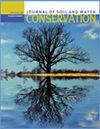Salinity and acid sulfate soils of the Vietnam Mekong Delta: Agricultural management and adaptation
IF 2.6
4区 农林科学
Q2 ECOLOGY
引用次数: 0
Abstract
O ne of the largest concentrations of acid sulfate soils in the world is found in the Vietnam Mekong River Delta, a large low-lying river plain scarcely above sea level, covering 1.6 million ha (4.0 million ac; figure 1) (van Mensvoort 1996; Vietnam Ministry of Agriculture 1978; Huu et al. 2022). Acid sulfate soils have high concentrations of aluminum (Al), sulfates (SO4 2–), and iron (Fe), and when drained produce sulfuric acid (H2SO4) that reduces soil pH below 4 (van Mensvoort 1996; Huu et al. 2022). These metals accumulate in the topsoil during the tropical dry season and are toxic to plant root growth and development and suppress yields making them some of the most difficult soils in which to grow agricultural crops. Yet, the Vietnam Mekong Delta produces 50% of Vietnam’s rice crop; 95% of rice exports; 65% of aquaculture production; 60% of exported fish; and 70% of the country’s fruit production (Loc et al. 2021). One of the keys to acid sulfate soil productivity is water-soil adaptive management that maintains crop-specific balance between reducing and oxidizing conditions in the plant rootzone at critical vegetative, bloom, and fruit development stages (Hanhart et al. 1997). More than 50 years ago vast areas of this delta were covered permanently by wetlands, brackish lagoons, tidal marshes, and mangrove forests. The prevailing winds of the southwest monsoon season brought predictable continuous heavy rains, a consistent 20-fold increase in Mekong River discharge and extensive prolonged flooding inundating lowlands for months (Adamson et al. 2009; Taylor 2014; Ngan et al. 2018). The monsoon is followed by a dry season when the rains stop and farmers adapt their cropping systems by growing flooded rice (Oryza sativa L.) varieties in the wet season and digging ditches and canals to drain the floodwater and convey fresh water from the Mekong (Song Tien) Lois Wright Morton is professor emeritus of rural sociology, College of Agriculture and Life Sciences, Department of Sociology and Criminal Justice, Iowa State University, Ames, Iowa, United States. Nghia Khoi Nguyen is associate professor in soil and environmental microbiology, College of Agriculture, Can Tho University, Can Tho City, Vietnam. M. Scott Demyan is associate professor of soil and environmental mineralogy, School of Environment and Natural Resources, The Ohio State University, Columbus, Ohio, United States. Received March 21, 2023. and Bassac (Song Hau) rivers and their tributaries to their fields for dry season crop irrigation. A changing climate—sea level rise, a stronger and increasingly variable SW monsoon, and more frequent and prolonged drought (Adamson et al. 2009)—in concert with amplified tidal effects and saltwater intrusion reaching 50 to 130 km (31 to 81 mi) upstream into the main rivers since February of 2020 threaten freshwater resources (Loc et al. 2021; World Bank 2022). A growing population, land use decisions, saline soils, loss of mangrove coastal protection, degraded wetlands, water and sediment flow dynamics affected by upstream dams, and mining of river sediments are challenging delta agriculture capacities to continue to provide an abundance of food and nutrition Figure 1 Saline and acid sulfate soils of the Vietnam Mekong Delta map. Saline soils of the Vietnam Mekong Delta peninsula are represented by dark purple (coastal mangrove soils) and two shades of lavender: strongly saline soils and moderate and slightly saline soils (lighter lavender). Acid sulfate soils are represented by shades of blue, with dark blue salt-affected potential acid sulfate soils where saltwater intrusion reaches into freshwater regions; mid-blues strongly acid sulfate soils; and lighter blue moderate and slightly sulfate soils. Alluvial soils (green), grey degraded soils, and grey degraded gleyic soils derived from old alluvium soil (very light green) are found along the mainstem Mekong and Bassac rivers and their distributaries. Scale 1:1,000,000. Image by Vietnam Ministry of Agriculture (1978).越南湄公河三角洲的盐碱化和酸性硫酸盐土壤:农业管理和适应
世界上酸性硫酸盐土壤浓度最高的地区之一是越南湄公河三角洲,这是一个几乎不高于海平面的大型低洼河流平原,占地160万公顷(400万英亩)。图1)(van Mensvoort 1996;越南农业部1978;Huu et al. 2022)。酸性硫酸盐土壤含有高浓度的铝(Al)、硫酸盐(SO4 2 -)和铁(Fe),排干时会产生硫酸(H2SO4),使土壤pH值降至4以下(van Mensvoort 1996;Huu et al. 2022)。这些金属在热带干旱季节积聚在表层土壤中,对植物根系的生长和发育有害,并抑制产量,使其成为最难种植农作物的土壤之一。然而,越南湄公河三角洲生产了越南50%的水稻作物;95%的大米出口;水产养殖产量的65%;60%的出口鱼类;占该国水果产量的70% (Loc等人,2021年)。酸性硫酸盐土壤生产力的关键之一是水-土壤适应性管理,在关键的营养、开花和果实发育阶段,维持植物根区还原性和氧化性条件之间的作物特异性平衡(Hanhart等人,1997)。50多年前,这个三角洲的大片地区被湿地、咸淡泻湖、潮汐沼泽和红树林永久覆盖。西南季风季节的盛行风带来了可预测的持续暴雨,湄公河流量持续增加20倍,洪水淹没低地数月(Adamson et al. 2009;泰勒2014年;Ngan et al. 2018)。季风过后是旱季,这时雨水停止,农民调整他们的种植制度,在雨季种植洪水水稻(Oryza sativa L.)品种,并挖掘沟渠和运河以排出洪水并从湄公河输送淡水(Song Tien)。Lois Wright Morton是美国爱荷华州艾姆斯市爱荷华州立大学农业与生命科学学院、社会与刑事司法系农村社会学名誉教授。Nghia Khoi Nguyen,越南芹苴市芹苴大学农学院土壤与环境微生物学副教授。M. Scott Demyan,美国俄亥俄州哥伦布市俄亥俄州立大学环境与自然资源学院土壤与环境矿物学副教授。收于2023年3月21日。和巴塞河(宋口河)及其支流到他们的田地用于旱季作物灌溉。不断变化的气候——海平面上升、更强且日益变化的西南季风、更频繁和更长时间的干旱(Adamson等人,2009年)——再加上潮汐效应的放大,以及自2020年2月以来流入主要河流上游50至130公里(31至81英里)的盐水入侵,威胁着淡水资源(Loc等人,2021年;世界银行(2022)。不断增长的人口、土地利用决策、盐碱地、红树林海岸保护丧失、湿地退化、上游水坝影响的水和沉积物流动动态以及河流沉积物的开采,都对三角洲农业继续提供丰富的食物和营养的能力构成挑战。图1越南湄公河三角洲盐碱地和酸性硫酸盐土壤地图。越南湄公河三角洲半岛的盐渍土壤以深紫色(沿海红树林土壤)和两种淡紫色为代表:强盐渍土壤和中度和轻度盐渍土壤(淡紫色)。酸性硫酸盐土壤以蓝色阴影表示,深蓝色的盐影响潜在的酸性硫酸盐土壤,其中盐水入侵到达淡水区域;中蓝色强酸性硫酸盐土壤;浅蓝色,中度和轻度硫酸盐土壤。冲积土(绿色)、灰色退化土和源自旧冲积土的灰色退化gleyic土(非常浅绿色)分布在湄公河主河和巴萨克河及其支流沿线。1:1,000,000规模。图片由越南农业部提供(1978年)。
本文章由计算机程序翻译,如有差异,请以英文原文为准。
求助全文
约1分钟内获得全文
求助全文
来源期刊
CiteScore
4.10
自引率
2.60%
发文量
0
审稿时长
3.3 months
期刊介绍:
The Journal of Soil and Water Conservation (JSWC) is a multidisciplinary journal of natural resource conservation research, practice, policy, and perspectives. The journal has two sections: the A Section containing various departments and features, and the Research Section containing peer-reviewed research papers.

 求助内容:
求助内容: 应助结果提醒方式:
应助结果提醒方式:


